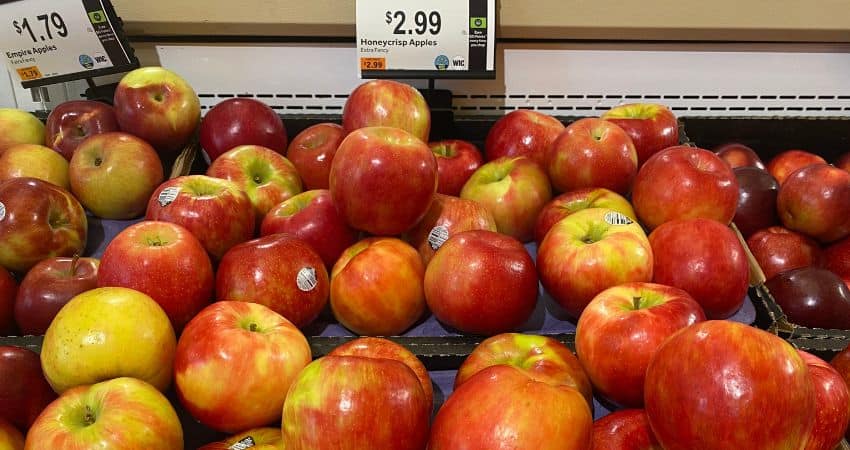A Guide To Choosing Apples
Once the type of apple is chosen, deciding on the best ones in the bunch may not be easy. Therefore, let’s find the answer to, how to choose apples?
The best way to choose apples:
- Buy apples locally.
- Choose apples with stems.
- Check the apple’s firmness.
- Examine for signs of rot.
- Choose apples with the deepest colors.
- Look for heavy apples.
- Choose organic apples.
Before you head out to the supermarket, reading this guide will help you choose the best apples. Let’s get started.

How To Choose Apples
As a Certified Health Coach many clients ask me about healthy food like choosing apples. They also know I purchase and consume apples almost everyday. Therefore, I have researched this topic in the past and present. Let’s examine them closely.
1. Buy Apples Locally.
Buying apples locally not only benefits you but also supports your local farmer and boosts your local economy. You’ll find the freshest, juiciest and healthiest ones at your local supermarkets.
Local apples taste much better because they have spent less time traveling from one state to another. They have encountered fewer bumps, temperature changes and nutrient losses.
If you shop locally, you’ll likely buy them within 24 hours after picking. Shockingly, the ones from supermarkets are typically stored for 9–12 months before hitting the shelves.
These apples can last this long because the farmers pick them before they turn ripe. They encounter certain chemicals and are stored in controlled conditions1. Ones that have not gone through this process will only last a few weeks.
If you buy them locally, you’re more likely to get the freshest and healthiest apples available. Look for supermarkets using local farmers. In addition, search out local farms or farm stands in your area.
2. Choose Apples With Stems.
Sometimes you’ll find apples in the markets with their stems removed or missing. The stem protects it from decaying faster because it prevents microorganisms from having access to them2.
An apple without a stem is like a house without a door, so avoid these and instead choose one still having its stem intact.
The stem, core and seeds contain nutrients as well as the skin and flesh. Although the stem and core of an apple contain the most bacteria3.
Without consuming the whole core, you’re only consuming 10% of the bacterial cells found in an apple, according to Frontiers of Microbiology4.
While some of this bacteria is beneficial, the seeds contain some poison and shouldn’t be consumed in large amounts. Therefore, buy ones with stems but remove them and the core prior to juicing or eating them.

3. Check the Apple’s Firmness.
Before choosing the apple, check the firmness.
To check an apple’s firmness gently squeeze it. If it is soft and dents easily, it’s not a firm one. Then tap it with the fingertip. The stronger the sound the more firm it is. A duller sound signals a mushier apple.
Be careful not to squeeze it too hard which may cause bruising. If the apple dents in easily, it will be mushy on the inside instead of crisp and fresh. Mushy ones mean they’re turning bad.
Therefore, go through the display until you find one that doesn’t dent when squeezed5.
However, if you want to make a smoothie, applesauce or something similar, then the softer ones may work just fine if enough firm ones are unavailable.
4. Examine For Signs Of Rot.
Another practical way to decide whether to choose a particular apple or not is by examining it for rot. It’s always best to choose one without bruises, dents or blemishes6.
Apples starting to rot are distinguished by:
- Dents
- Bruises
- Blemishes
They will have a mushy texture when you eat them and won’t be as flavorful as you’d like. However, they’re still safe to consume once you remove the bruised areas7.
Avoid ones with cuts and or slices which may occur during picking, traveling or storage. The cut exposes the flesh and makes the area turn.
To avoid rotten apples, look out for the following:
- Brown in color
- Wrinkly skin
- Holes
- Mold
- Liquid coming out of them
Eating rotten ones may make you sick, so always avoid them. If you see a rotten apple on display, call a staff member and point the rotten apples out to them. This way they can remove them from the shelves, preventing others from getting sick.
In addition, they emit ethylene gas which speeds up the rotting process. Removing bad apples from the store or home will help save the remaining apples longer.
Rotten apples can cause nausea, upset stomach, diarrhea and vomiting. Mold growth from a rotten one may cause allergic or respiratory reactions.
5. Choose Apples With the Deepest Colors.
When choosing apples, always choose ones with the deepest colors. The deeper color apples have the best flavor, are healthier and typically larger.
The deepest, fullest colors indicate it grew facing the sun. These are a better quality than those exposed to less sunlight.
Although deep-colored ones should be chosen, avoid the shiny ones when buying them from a supermarket. They often come from a layer of wax applied to the skin.
If it is fresh from the local food market or farm stand, the waxy shine is typically natural as the apple produces it.
However, if the apple is store-bought, that shine is a synthetic wax and can disguise the quality. Anaerobic respiration can occur in the apple from synthetic wax, resulting in a shiny, firm fruit on the outside but soggy on the inside.
This synthetic wax can also have negative effects on your body, so choose the less shiny ones when shopping in a supermarket.
6. Look for Heavy Apples.
The biggest one is usually one catching your eye first, and finding it can feel like a big win. However, it may not be, as the largest apples may be the ones with the most water. These will be juicy, but they might not have much flavor.
However, this isn’t always the case. No matter the size, you want the apple to be heavy. If it’s light for its size, it means it is starting to dry out. Instead, put the light one back in its basket and look for a heavier one.
If you’ve found a large, heavy one, you indeed have found a winner.
7. Choose Organic Apples.
Non-organic apples are treated with pesticides to keep the trees free of bugs. They carry some of those pesticides with them to the store which is why cleaning them prior to eating them is important.
The Environmental Working Group (EWG) publishes a yearly list of the dirtiest and cleanest fruit and vegetables. It’s a list of conventionally grown fruits and vegetables with the highest and lowest amounts of pesticide residue8.
The 2021 EWG Dirty Dozen list has apples as number five following strawberries, spinach, kale and nectarines. This means of all the fruits, conventional apples have more pesticide residue than most fruits.
For this reason, choosing organic is the better choice.
If you have any questions to ask me about this article don’t hesitate to comment below or email us. You can find an email on our contact page.
Read Next – More Anti-Aging Food Articles
Empire vs Red Delicious Apples: The Ultimate Comparison
Fuji vs. Gala Apples – A Complete Comparison
Gala Vs Empire Apples – The Differences
Fuji Apple vs McIntosh – What’s The Difference?
10 Health Benefits of Chinese Leaf
Will Almond Milk Break My Fast?
Are Cabbage Rolls Healthy? (Everything You Need To Know)
What Is Blanched Almond Flour and Its Benefits
- National Center for Biotechnology Information: A mechanistic modelling approach to understand 1-MCP inhibition of ethylene action and quality changes during ripening of apples [↩]
- Apples: Do apples need to be harvested with stems? [↩]
- Frontiers in Microbiology: An Apple a Day: Which Bacteria Do We Eat With Organic and Conventional Apples? [↩]
- Today: Study claims we’ve all been eating apples wrong-here’s why [↩]
- University of Illinois Extension: Apples and More [↩]
- The University Of Tennessee: Selecting Quality Apples [↩]
- National Center for Home Food Preservation: Apples are Peaking; Choose the Best Preservation Method [↩]
- EWG: Dirty Dozen [↩]
